Today Friday 6th December 2019 marks the first anniversary of the launch of the Fridays for Future climate strike in Ireland.
At a conference last weekend in Dalgan Park, hosted by the Columban Ecological Institute on the topic ‘Climate Change: Where Are We Now?’, Dr Lorna Gold recalled how she had been on her way to do Christmas shopping last year when she heeded Greta Thunberg’s call to action and became a co-founder of the Fridays for Future climate strikes in Ireland.
Dr Gold, who is Coordinator of Trócaire’s Laudato Sí Project, reminded the Dalgan conference participants how the very first climate strike began on 20 August 2018, when schoolgirl Greta Thunberg sat outside the Swedish parliament every school day for three weeks to protest at Swedish politicians’ inaction on climate change.
 After three weeks of striking full-time, Greta Thunberg decided to continue her strike every Friday until the Swedish government introduced policies to help global warming stay below two degrees Celsius above pre-industrial levels.
After three weeks of striking full-time, Greta Thunberg decided to continue her strike every Friday until the Swedish government introduced policies to help global warming stay below two degrees Celsius above pre-industrial levels.
As her following grew, Greta Thunberg was invited to address world leaders at the UN’s Climate Talks in Poland in December 2018, where she told them they had failed to take action on the climate crisis.
At the conference in Dalgan on 30 November, Dr Gold told over 70 people that Greta Thunberg “issued an invitation to everybody to go on strike that particular Friday in recognition of the inaction and the climate emergency. So, a few of us heard that in Ireland and myself and Barry McMullen and a couple of others ended up outside Dáil Eireann. I was actually on my way to go Christmas shopping that day – but something in me made me change my plans – just this sense of the urgency of this crisis and the need to wake people up.”
Thunberg’s call to action also inspired hundreds of young people across the world to start their own strikes including here in Ireland.
“Ever since there have been weekly climate strikes in Ireland. In fact, one of them was here in Dalgan when we gave the awards to the young people in June for the journalism competition,” Dr Gold recalled. (Following the presentation of awards in the Columban Schools Journalism Competition)
As part of the Fridays for Future Ireland movement, weekly demonstrations have been taking place in Cork outside City Hall, in Dublin outside Dáil Éireann, in Maynooth at Courthouse Square, and in Limerick outside the Council buildings as well as elsewhere.
Globally, the largest strikes so far took place on 15 March 2019 when over a million people took part in scores of countries around the world; then on 20 September 2019, a staggering 4 million people took part in a climate strike and a week later on 27 September 2019, 2 million people marched in defence of the climate.
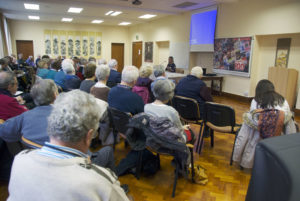 In her address to the Dalgan conference, Dr Lorna Gold, looked at where the climate movement in Ireland is at after one year of strikes.
In her address to the Dalgan conference, Dr Lorna Gold, looked at where the climate movement in Ireland is at after one year of strikes.
“It has been an incredible year in some ways,” the mother and activist commented, highlighting how the climate strike movement has changed the dynamics of public understanding of climate change.
Young people in particular, she said, have a very high level of awareness and understanding and scientific knowledge of the issue.
They have changed the narrative, she suggested, which has moved out of the economic sphere and into a moral debate about what are the current generation prepared to do to save the future of the younger generation, including their own children and grandchildren, nephews and nieces.
“I think that young people have really put it up to us as a generation in terms of that IPCC mantra: ‘Every action counts, every choice we make counts, every bit of warming counts’ and are asking us what we are prepared to do?”
She said the climate strike movement had “grown dramatically in Ireland after a slow start before Christmas 2018”.
The author of ‘Climate Generation: Awakening to Our Children’s Future’ asked how do those children who are mobilised find their voice in this climate debate?
She paid tribute to supportive schools and supportive teachers who help their students to get out on the streets. She also paid tribute to the weekly climate strikers – “our own Greta Thunbergs that have emerged in Ireland”.
She also noted the “dramatic growth” in the non-violent direct-action group Extinction Rebellion movement here in Ireland and beyond, whose actions are a statement that “we need to be prepared to put our bodies on the line in order to safeguard the future”.
This interest in the climate issue which has grown dramatically is rooted in communities and dominated by young people and the retired.
“They are the two main groups in the climate movement but there are people missing. There are groups that are still not engaged in the climate debate. The farmers groups are engaged but in a different way; we have not managed to make any significant advances on the engagement of the farming community,” she highlighted.
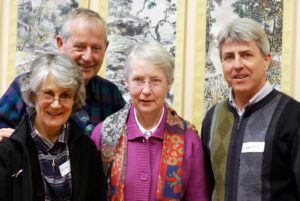 “So, the climate movement is growing strongly; we are in a really good place in terms of the growing movement here in Ireland and the narrative that has developed around the next generation and the fact that we need to step up and the urgency of it,” Dr Gold observed.
“So, the climate movement is growing strongly; we are in a really good place in terms of the growing movement here in Ireland and the narrative that has developed around the next generation and the fact that we need to step up and the urgency of it,” Dr Gold observed.
Asking ‘Where next?’, she said that while gains have been made in public consciousness, in media coverage and even the youth assembly that was held in Dáil Eireann where young people put their climate proposals on the table and that the national climate plan is enhanced by the growing public awareness, the fact is that “we are nowhere near where we need to be in terms of the kind of action that we need to be taking to avert all the climate tipping points that Professor John Sweeney highlighted in his address (to the same conference).
She warned that “Even with the new climate plan in place and all the additional measures that are proposed under that plan currently, Ireland’s climate emissions reductions will be marginal over the next 11 years.”
“If we want to be in line with our moral obligation to the rest of the world and to future generations, we need to be reducing emissions by 11% per year. We are nowhere near even contemplating what that means,” she challenged.
To do this, Dr Gold suggested that “we need to imagine a new paradigm for economics and society; we need to be thinking in very different terms about what it means to be a human being and about our interactions and how we operate as a society. Ireland at the moment is not even contemplating that kind of shift.”
Elsewhere in her talk she indicated that, “The kind of paradigm that we need to be looking at is one that I would say is very much outlined in Laudato Si.”
She also noted that while the Irish climate movement has many different groups involved at the moment and lots of energy and action, “what we need to be doing now is to translate all of that into proposals – proposals for action and proposals for change that can be put into policies and into ideas.
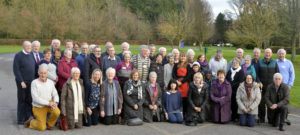 She highlighted the emergence of a new Green New Deal Coalition and asked what significant shifts are needed in our society right now in order to tip us into drastically reducing our emissions. “That Green New Deal idea has been floating around for a while and you will see it mentioned by every political party now in some shape or form in the next general election. There is a real need for the climate movement to start to join together to develop concrete proposals and demands on what a green new deal would look like in light of the climate emergency.”
She highlighted the emergence of a new Green New Deal Coalition and asked what significant shifts are needed in our society right now in order to tip us into drastically reducing our emissions. “That Green New Deal idea has been floating around for a while and you will see it mentioned by every political party now in some shape or form in the next general election. There is a real need for the climate movement to start to join together to develop concrete proposals and demands on what a green new deal would look like in light of the climate emergency.”
In his address, Professor John Sweeney, the country’s foremost climate scientist told the Dalgan conference that he would like to see Ireland’s climate action plan being strengthened and the target dates for things to happen being brought forward to reflect the seriousness of the situation.
“I would like to see politicians on all scales being forced to consider better the climate impacts of their decisions for development plans for example, for critical infrastructure in particular, so that we are not passing on costs to the next generation which we could otherwise avoid.”
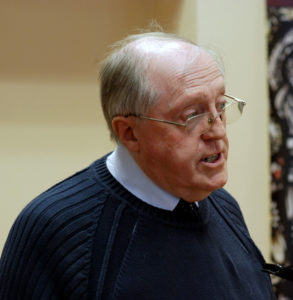 Professor Sweeney described Pope Francis’ leadership on this issue as “a beacon of light” in the past few years.
Professor Sweeney described Pope Francis’ leadership on this issue as “a beacon of light” in the past few years.
He also hit at out the US bishops warning that their conservatism on the climate issue would ultimately come back to haunt them. “I think they are going to be identified very closely with Donald Trump unfortunately and that will not help, keeping the flock together in the US. Just as in the rest of the world, the younger population, which have been deserting the church in droves – this is an issue that would bring them back in droves if it was properly handled.”
On the Amazon Synod, Professor Sweeney said he hoped that in the final report of the synod, Pope Francis would have the “courage to stick to his guns on what he was proposing because to my way of thinking it is the only way ahead for a modern church. We can’t regress into a populist type leadership in the church the same way we have in politics…”
“I think the church needs to be at the vanguard of the difficult moral decisions around living in a common home.”
In his address, Professor Sweeney highlighted how rainfall is a key variable for many parts of the world. The impact of climate change would result in those places that get too much rain getting more rain while the places that don’t get enough rain will get less.
He highlighted how extreme poverty is expected to grow in Africa as a result of the environmental harshness of the continent, its rapid population growth and the vagaries of climate fluctuation which Africa will face.
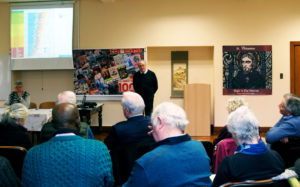 “When you are under stress, your agriculture begins to fail as well.” According to the IPCC, we can expect yields from rain fed agriculture to be reduced by half in the next decade or so. “So food security becomes a growing problem.”
“When you are under stress, your agriculture begins to fail as well.” According to the IPCC, we can expect yields from rain fed agriculture to be reduced by half in the next decade or so. “So food security becomes a growing problem.”
Another vulnerable area is those locations where people live very close to sea level. “Where they live one or two metres above the present sea level. Their cultures are going to be threatened by a global rise in sea levels.” He said this included coral atolls of the Indian Ocean and the Pacific where hundreds of thousands of people live very close to existing sea level.
The moral and ethical maze was how do we tackle this problem and who is responsible when a country drowns. “Who is responsible when whole cultures are in danger of being dispersed and to a large extent extinguished as well?”
Elsewhere the mega deltas of Asia and Africa would see a major impact. Bangladesh was, he warned, perhaps the most vulnerable country of them all. “Where do these 160 million people go as their homeland becomes submerged? If we think we have a problem with the movement of people across the Mediterranean, this is something that is going to become much more serious when the Asian mega deltas begin to flood. Even a rise in sea level of 1 metre would mean Bangladesh would lose a quarter of the country. “We confidently expect that to occur by the end of this century.”
“Nature is already telling us that things are happening on a grand scale.”
“Ireland is not immune. We know Ireland is half a degree warmer in every month of the year than it was 30 years ago. We are experiencing climate change here in Ireland. We know that will continue from the modelling we have done in Maynooth. We know it is going to be another half degree in the next 30 years and we are going to see a lot more changes in our rainfall with the West getting more in the winter and the East getting less in summer, creating a flood problem in the winter and a drought problem in the summer months.” Jetstream aberrations were linked to the increased rainfall and there had also been extreme hurricane events in recent years.
 According to Professor Sweeney, “One of the main drivers of (the decline in) biodiversity is climate change. We are seeing biodiversity decline now faster than at any time in human history. The world is changing quite quickly and as you reduce biodiversity and simplify biodiversity you increase vulnerability – as you increase the problems of less diversity to cope with the future.”
According to Professor Sweeney, “One of the main drivers of (the decline in) biodiversity is climate change. We are seeing biodiversity decline now faster than at any time in human history. The world is changing quite quickly and as you reduce biodiversity and simplify biodiversity you increase vulnerability – as you increase the problems of less diversity to cope with the future.”
He told the conference participants that they should expect to see species that were taken for granted in the past, for example listening to the curlew on the bog, to disappear. “There are only 160 Curlew breeding pairs left now – they are going to be the next casualty of the climate crisis.”
Discussing the question of what Ireland’s fair share is of what is left in the carbon budget, Professor Sweeney explained that when the equity calculations are done, Ireland has about another 5 years or so left before it enters into carbon debt to the rest of the world. “Carbon debt is going to become the new currency by the middle of the 2020s.”
He acknowledged that Ireland has done some things very well. For example, being the first country in the world to achieve divestment of its national sovereign wealth fund. “That was a huge achievement that was aided by the NGOs.”
“But ultimately,” he stressed, “this is a problem that is not purely economics and it is not purely financial – it is a problem of inter-generational equity. It is about what kind of world we want to leave behind.”
He concluded by quoting from the IPCC mantra: “Every action matters, every bit of warming matters, every year matters, and every choice we make matters.”
Follow us on Twitter @IrishColumbans

